|
|
|
|
|
- (2 weeks, 1 day):
 3 germ layers 3 germ layers Rostral-caudal orientation Rostral-caudal orientation- (2 weeks, 2 days):
 Erythroblasts in yolk sac Erythroblasts in yolk sac Three types of blood-forming cells in Three types of blood-forming cells in- yolk sac
 Amnion with two cell layers Amnion with two cell layers Secondary villi Secondary villi- (2 weeks, 4 days):
 Foregut, midgut, and hindgut Foregut, midgut, and hindgut Brain is first organ to appear Brain is first organ to appear Neural plate induced by notochordal Neural plate induced by notochordal- process
 Connecting stalk Connecting stalk- (2 weeks, 6 days):
 Numerous blood islands in umbilical Numerous blood islands in umbilical- vesicle
 Foregut Foregut Stomodeum forming Stomodeum forming Beginnings of the heart can be seen Beginnings of the heart can be seen Blood vessels emerge simultaneously in Blood vessels emerge simultaneously in- umbilical vesicle, embryo proper, amnion,
- and connecting stalk
 Dorsal aortae (paired) Dorsal aortae (paired) Paired tubular heart Paired tubular heart Forebrain, midbrain, and hindbrain Forebrain, midbrain, and hindbrain Neural groove deepens substantially Neural groove deepens substantially Three main divisions of brain Three main divisions of brain Neural crest: Rostral and facial Neural crest: Rostral and facial- (3 weeks):
 Blood and blood vessels Blood and blood vessels- Less Events...
|
|
|
|
|
|
|
|
|
|
|
|
|
|
|
|
|
|
|
|
|
|
|
|
|
|
|
|
|
| Fertilization |
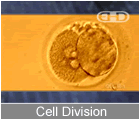
|
| Week 1 ends |
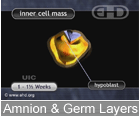
|
| Week 2 ends |
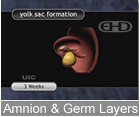
|
| Week 3 ends |
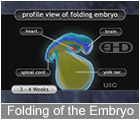
|
| Week 4 ends |
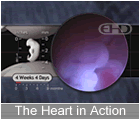
|
| Week 5 ends |
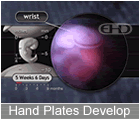
|
| Week 6 ends |
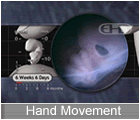
|
| Week 7 ends |
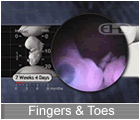
|
| Week 8 ends |
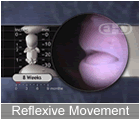
|
| Week 9 ends |
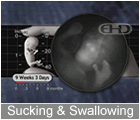
|
| Week 10 ends |
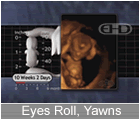
|
| Week 11 ends |
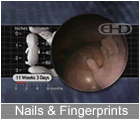
|
| Month 3 ends |
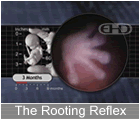
|
| Month 4 ends |
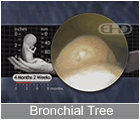
|
| Month 5 ends |
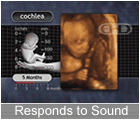
|
| Month 6 ends |
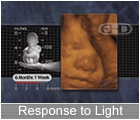
|
| Month 7 ends |
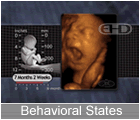
|
| Month 8 ends |
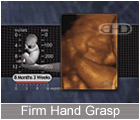
|
| Month 9 ends |
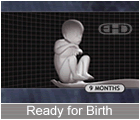
|
| Birth |
|
|
|
|
|
|
|
- (3 weeks, 1 day):
 Midgut emerging Midgut emerging Respiratory outgrowth Respiratory outgrowth Atria (right and left) far apart Atria (right and left) far apart Circulatory system function begins Circulatory system function begins Endocardial tubes fuse forming tubular Endocardial tubes fuse forming tubular- heart
 Heart begins beating Heart begins beating Pericardium Pericardium Primary head vein Primary head vein Sinus venosus Sinus venosus Tubular heart begins folding Tubular heart begins folding Umbilical arteries Umbilical arteries Umbilical veins (right and left) Umbilical veins (right and left) Neural tube Neural tube Body cavities Body cavities Hyoid arch Hyoid arch- (3 weeks, 3 days):
 Thyroid complete Thyroid complete Cystic primordium Cystic primordium Liver Liver Membrane between future mouth and throat Membrane between future mouth and throat- may begin to rupture
 Internal carotid arteries Internal carotid arteries Neuropore (near brain) closes Neuropore (near brain) closes Notochord Notochord- (3 weeks, 5 days):
 First part of pancreas First part of pancreas Pharyngeal arch 3 Pharyngeal arch 3 Lung bud Lung bud Descending aorta Descending aorta Unidirectional circulation Unidirectional circulation Brain involves 40% of neural tube Brain involves 40% of neural tube Lowermost spinal cord formation begins Lowermost spinal cord formation begins Neural tube closes (lower back) Neural tube closes (lower back) Somites: Pairs 21 through 29 Somites: Pairs 21 through 29 Upper limb primordium at level of Upper limb primordium at level of- somites 8 to 10
 Progressively C-shaped embryo Progressively C-shaped embryo- (4 weeks):
 Skin is so thin, you can see through it! Skin is so thin, you can see through it! Esophagus primordia Esophagus primordia Intestines growing in length Intestines growing in length Pancreas: Ventral pancreas Pancreas: Ventral pancreas Pharynx Pharynx Small & large intestines Small & large intestines Bronchial buds Bronchial buds Lungs begin filling chest cavity Lungs begin filling chest cavity Trachea Trachea Circulatory system "well established" Circulatory system "well established" Functioning two-chamber heart Functioning two-chamber heart Heart chambers bulging with fluid Heart chambers bulging with fluid Heart now functions as two parallel Heart now functions as two parallel- pumps
 Heart rate (about) 113 beats/min Heart rate (about) 113 beats/min Most cranial nerve ganglia Most cranial nerve ganglia Cerebellum Cerebellum Fourth ventricle Fourth ventricle Amnion surrounds embryo Amnion surrounds embryo Limb buds - the first sign of arms and Limb buds - the first sign of arms and- legs
 Lower limb buds Lower limb buds Umbilical cord emerging Umbilical cord emerging Upper and lower limb buds Upper and lower limb buds- Less Events...
|
|
|
|
|
- (5 weeks, 1 day):
 Wrist joints are forming Wrist joints are forming- (5 weeks, 2 days):
 Thyroid detaches from pharynx Thyroid detaches from pharynx Atrioventricular (AV) node Atrioventricular (AV) node Circle of Willis almost complete Circle of Willis almost complete Cochlear nerve present Cochlear nerve present Musculocutaneous, radial, ulna, and Musculocutaneous, radial, ulna, and- median nerves enter upper limb bud
 All cranial nerves identifiable All cranial nerves identifiable- (5½ weeks):
 Initial tooth formation Initial tooth formation- (5½ weeks - 6 weeks):
 Subtle movement begins Subtle movement begins- (5 weeks, 4 days):
 Cartilage formation Cartilage formation- (5 weeks, 5 days):
 Nerve cells differentiating Nerve cells differentiating- (5 weeks, 5 days - 7 weeks, 1 day):
 Melanocytes in epidermis Melanocytes in epidermis- (5 weeks, 6 days):
 Cartilage in occipital sclerotomes (1-4) Cartilage in occipital sclerotomes (1-4) Primordial vermiform appendix Primordial vermiform appendix All spinal nerves present All spinal nerves present Dura begins forming in basal area Dura begins forming in basal area Frontal and temporal poles of cerebral Frontal and temporal poles of cerebral- hemispheres
 Somites: Pairs 38 and 39 Somites: Pairs 38 and 39 Synapses in spinal cord between Synapses in spinal cord between- interneurons and primary afferent neurons
- (6 weeks):
 Face withdraws from light touch around Face withdraws from light touch around- mouth
 Blood forming in liver Blood forming in liver Nipples along side of trunk Nipples along side of trunk Adrenal glands Adrenal glands Glucagon in pancreas Glucagon in pancreas Handplates develop subtle flattening Handplates develop subtle flattening Joints Joints Tooth buds (primary teeth) Tooth buds (primary teeth) Diaphragm is largely formed Diaphragm is largely formed Intestines fill base of umbilical cord Intestines fill base of umbilical cord Synapses form in spinal cord Synapses form in spinal cord Crown-heel length 1.6 cm Crown-heel length 1.6 cm- Less Events...
|
|
|
|
|
- (7 weeks, 1 day):
 Upper limbs with slightly flexed elbows Upper limbs with slightly flexed elbows Sacrocaudal spinal cord formation Sacrocaudal spinal cord formation- (secondary neurulation) complete
- (7 weeks, 1 day - 8 weeks):
 Stomach: Folds in stomach wall Stomach: Folds in stomach wall- (7 weeks, 2 days):
 Arteries and veins of heart complete Arteries and veins of heart complete- (7 weeks, 3 days):
 The knee joints have arrived The knee joints have arrived Wrists slightly flexed Wrists slightly flexed Eyelids growing rapidly Eyelids growing rapidly Cerebral hemispheres cover more than Cerebral hemispheres cover more than- half of diencephalon
- (7½ weeks):
 Hands begin to touch face Hands begin to touch face The hands touch each other as do the The hands touch each other as do the- feet!
 Fingertips thicken Fingertips thicken Plantar pads toes Plantar pads toes EKG pattern similar to adult EKG pattern similar to adult- (7 weeks, 4 days):
 The fingers are free The fingers are free- (7 weeks, 5 days):
 Bone-forming cells called osteoblasts Bone-forming cells called osteoblasts- emerge
 Hands can reach one another and fingers Hands can reach one another and fingers- can overlap
 Brain: Internal capsule with connections Brain: Internal capsule with connections- to epithalamus, dorsal thalamus, and
- mesencephalon
 Cerebral hemispheres cover 75% of Cerebral hemispheres cover 75% of- diencephalon
 Cortical plate expanding rapidly Cortical plate expanding rapidly- (7 weeks, 6 days):
 The toes are free The toes are free- (8 weeks):
 Complex response to touch Complex response to touch More frequent hand-to-face contact More frequent hand-to-face contact Mouth opens & closes Mouth opens & closes Squinting Squinting The embryo floats and rolls over in the The embryo floats and rolls over in the- womb
 Hairs first appear in eyebrows & around Hairs first appear in eyebrows & around- mouth
 Skin multi-layered, loses transparency Skin multi-layered, loses transparency Male embryos are making testosterone Male embryos are making testosterone- already!
 The embryo's joints are similar to adult The embryo's joints are similar to adult- joints
 Diaphragm complete Diaphragm complete Esophagus: Longitudinal muscles Esophagus: Longitudinal muscles Urethra Urethra Urine production and release Urine production and release Peristalsis in large intestine Peristalsis in large intestine Occasional breathing motions begin Occasional breathing motions begin Blood supply to the brain closely Blood supply to the brain closely- resembles adult pattern
 Cranial nerve distribution mimics adult Cranial nerve distribution mimics adult- pattern
 Retina: Four of the ten adult layers Retina: Four of the ten adult layers- present
 Tympanic membrane Tympanic membrane "The hindbrain "presents striking "The hindbrain "presents striking- resemblance to that of the newborn."
 Brain represents 43% of embryo Brain represents 43% of embryo Grey and white matter Grey and white matter Right- and left-handedness emerges Right- and left-handedness emerges Crown-heel length 4.3 cm Crown-heel length 4.3 cm Embryo contains approximately 1 billion Embryo contains approximately 1 billion- (10^9) cells
 Embryonic Period Ends Embryonic Period Ends The 8-week embryo has formed more than The 8-week embryo has formed more than- 4,000 permanent body parts.
- Less Events...
|
|
|
|
|
|
|
|
|
|
|
|
|
|
|
|
|
- (34 weeks):
 Rapid weight gain Rapid weight gain-
- (35 weeks):
 Firm grip Firm grip Amniotic fluid volume peaks Amniotic fluid volume peaks-
- (36 weeks):
 Surfactant production accelerates Surfactant production accelerates Brain weight 300 grams Brain weight 300 grams Crown-heel length 48.5 cm Crown-heel length 48.5 cm
|
|
|
|
|